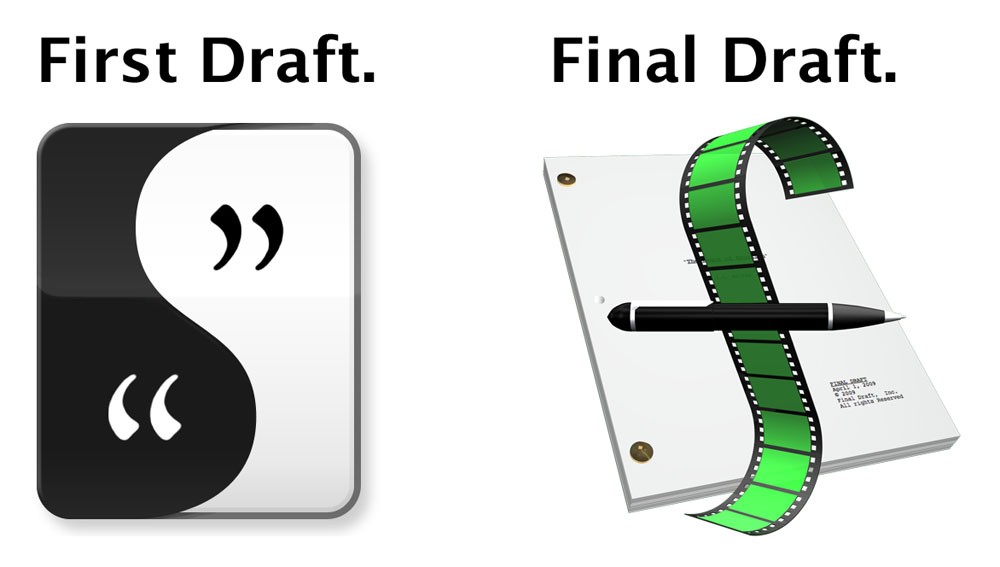For all those scriptwriters out there, and for all those who don’t already know, Final Draft 8 was finally released not long ago. Final Draft is, of course, the industry standard of scriptwriting programs, and version 8 brings with it a raft of new features and an overhaul to the interface that makes it feel much more like a native Mac app than previous versions. I won’t go into the various new features - navigator, improved index card navigation, new interface, and so on - here; instead, I just thought I’d say a few words about Final Draft’s relationship with Scrivener.
When Scrivener was in the early beta stages a few years ago, there were a number of frustrated Final Draft users who, wanting more organisational tools than Final Draft provided (and to be able to use something more “Mac-like”), asked me to provide scriptwriting features in Scrivener so that scriptwriters, too - along with writers of other types of prose - could draft and structure in Scrivener and then export to Final Draft for the - er - final draft (and production and so on). Because of those early pleas, Scrivener now has a scriptwriting mode, and I’m glad it does, as I like using it for playing around with dialogue and other formats myself (not to mention that my most recent endeavour in my never ending quest not to finish a work of fiction is a graphic novel, or comic, or something). But Scrivener isn’t a dedicated scriptwriting program and most scriptwriters will still need such software for preparing their script for submission or production, so it’s great to see a much anticipated Final Draft update prove worth the wait.
With the help of the nice people at Final Draft, a recent update to Scrivener introduced .fcf (Final Draft File Converter Format) export, making it relatively straightforward for users to export to previous versions of Final Draft, but the most recent updates - 1.5x onwards - also include .fdx import and export; FDX (Final Draft XML) is Final Draft’s new default format, replacing FDR. Scrivener 2.0’s support for FDX will be even more advanced, allowing users to keep synopses (summaries in Final Draft) and structure intact when transferring files between the programs, but for now, Scrivener 1.5x’s FDX support is already great for getting your work out to Final Draft. (The FDX format is something I’m not used to - a good XML format. You can open it up in any text editor and it is easily readable. I’m going to blog on the woes of the .pages format a little later, but for now, suffice to say that I wish Microsoft and Apple had come up with a format as nice as .fdx when designing their .docx or .pages formats; and yes, I know that’s unrealistic for many, many reasons, but I can still wish, can’t I?)
At this stage, lest this comes across as an advert for Final Draft, I should say that we are in partnership with Final Draft Inc. (you can see as much on their partners page - I suppose we ought to have one of those, except we’d only have one company to put on there!). But all that means is that I e-mailed them a year or so ago, explained what Scrivener did, and asked if there was any way they would be willing to let me have access to one of their formats so that I could provide an importer and exporter. I expected that to be that, and that I would never hear back from them; instead I received a very helpful e-mail, followed by a phone call. They gave me access to the .fcf format and later suggested I support .fdx too; they’ve kept in touch ever since and even made time to meet with us on a couple of occasions. They didn’t need to do any of that; we are small fry (for now - obviously the long-term plan is world domination), but they just seemed to have a very open attitude towards other programs, and that’s something I really appreciate.
Anyway, now that Final Draft 8 is out, a few users have asked, do I really need both programs now? Can’t I do it all in Final Draft? And inevitably, in a couple of Mac reviews of Final Draft, Scrivener has come up as a competitor. Scrivener is, of course, in no way direct competition to Final Draft (or Movie Magic Screenwriter or Montage for that matter), any more than it is in direct competition to Word or Pages. Scrivener is still very firmly about the first draft stages of a writing project. It is - I hope - great for organising ideas, structuring the project, and then hammering out that first draft of a script or novel (or legal document or thesis). But just as for the majority of cases you would take a thesis written in Scrivener to a word processor for final formatting, you are equally likely to take a screenplay written in Scrivener to a dedicated program such as Final Draft for the last stages of its development (the only reason I didn’t say stage play there as I am aware the requirements for stage plays vary).



0 Comments
Please sign in or register to comment on this post.
Register
Sign in
Forgotten password